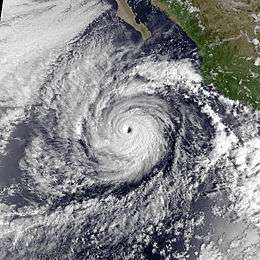Hurricane Trudy (1990)
| Category 4 major hurricane (SSHWS/NWS) | |
 Hurricane Trudy near peak intensity | |
| Formed | October 16, 1990 |
|---|---|
| Dissipated | November 1, 1990 |
| Highest winds |
1-minute sustained: 155 mph (250 km/h) |
| Lowest pressure | 924 mbar (hPa); 27.29 inHg |
| Fatalities | None |
| Damage | Minimal |
| Areas affected | Mexico, Socorro Island, Western United States |
| Part of the 1990 Pacific hurricane season | |
Hurricane Trudy was a very powerful, very long-lived late-season hurricane that formed in October of 1990. The 20th named storm and 26th tropical cyclone of the above-average 1990 Pacific hurricane season, it formed as a tropical wave which moved across the northeast Pacific and formed a tropical depression south of Mexico on October 16. It strengthened at a moderate pace and reached hurricane intensity on October 18. Trudy entered a favorable environment and explosively intensified, reaching its first peak in strength on October 20. At that time, an upper-level trough drifted Trudy north, which increased vertical shear, causing it to substantially weaken the system back to Category 1 hurricane status. The trough outran the storm and was replaced by a ridge which turned the storm back to the west and led to its re-intensification to a Category 4 hurricane. Another upper level trough approached which pulled Trudy northward once again, and sheared the hurricane apart. The cyclone dissipated on November 1. Eventually, some of its moisture spread over parts of Mexico and the United States.[1]
Meteorological history

The tropical wave that would become future Hurricane Trudy became identifiable on satellite imagery as early as September 30, emerging near the African coast off Cape Verde. However, the wave did not show any signs of development until October 16, when the wave developed into a tropical depression several hundred kilometers south of Acapulco. The tropical depression intensified significantly. The ship Maple Ace reported tropical storm-force winds about 140 km (87 mi) from the center at 1800 UTC on October 18. In less than 36 hours, at 1200 UTC on October 20, Trudy became a powerful hurricane with Category Four equivalent maximum winds of 155 mph (249 km/h) and a minimum pressure of 925 mbar (27.3 inHg) according to satellite estimates. The hurricane was at least as intense as Hurricane Max three years earlier and Hurricane Hernan earlier in the year. Estimates state that Trudy may have been the strongest eastern Pacific hurricane since wind estimates have been available from satellite images.[2]
An upper-level trough forced Trudy to move northwards, increasing the risk of hurricane conditions to Baja California residents. The same trough caused an unfavorable environment that caused Trudy to weaken considerably. At that time, dynamically based numeral models forecasted Trudy to move northwards over Baja California and make landfall there. However, the trough progressed eastwards and was replaced by a ridge, and Trudy assumed a westward motion away from land. Trudy then started to re-intensify, developing an unusually large eye of nearly 90 km (56 mi) in diameter.[2] However, another deep trough approached Trudy and pulled the hurricane northwards, shearing it at the same time. Trudy dissipated on November 1 at 1800 UTC. Its remnant moistures spread over parts of Mexico and the United States.[2]
Preparations, impact, and records
Authorities closed five ports on Baja California and the Pacific Ocean port of Mazatlán on October 22 as Hurricane Trudy was approaching the Mexican coast with gusts of up to 115 mph (185 km/h).[3] The outer bands of Trudy produced heavy rains in Mazatlán when the cyclone was moving slowly offshore.[3] High waves produced by Trudy were reported in Cabo San Lucas. Offshore, Socorro Island reported hurricane-force winds for more than 7 hours.[4]
See also
References
- ↑ Avila, Lixion (1991). "Hurricane Trudy Preliminary Report, Page 1". National Hurricane Center. Retrieved 2013-05-26.
- 1 2 3 Avila, Lixion (1990). "Eastern North Pacific Season of 1990" (PDF). Monthly Weather Review (National Hurricane Center) 119 (8): 2034. Bibcode:1991MWRv..119.2034A. doi:10.1175/1520-0493(1991)119<2034:ENPHSO>2.0.CO;2. ISSN 1520-0493. Retrieved 2013-05-26.
- 1 2 United Press International (1990-10-23). "Hurricane Trudy Closes Six Ports". The Lodi News-Sentinel. Retrieved 2013-05-26.
- ↑ Avila, Lixion (1991). "Hurricane Trudy Preliminary Report, Page 2". National Hurricane Center. Retrieved January 2, 2011.
External links
| |||||||||||||
